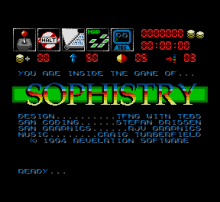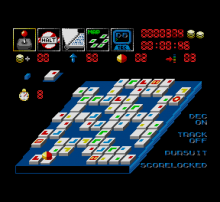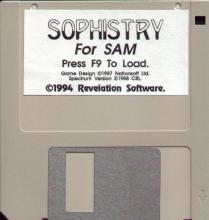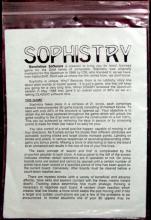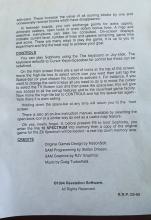Sophistry
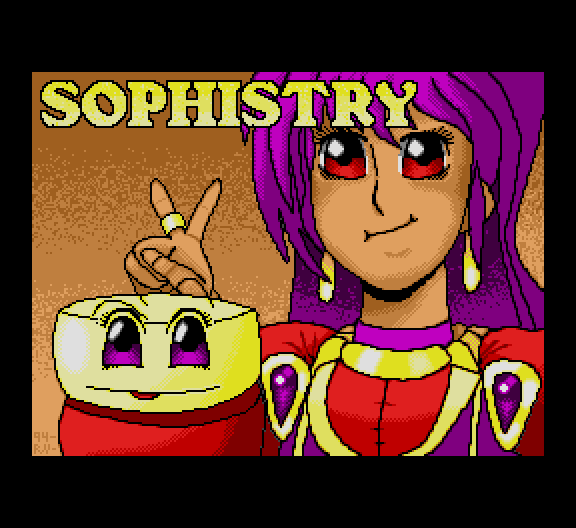
Download
Release Year
Copyrights
Copyright Provenance
Description
Escape from this puzzley world via the highest level. Collect or buy keys to open up passages to get higher. Various types of level with blocks that decrease in value and disappear when left, timed attempts and more.
Instructions
Revelation Software is pleased to bring you its latest licensed game for the SAM family of computers. Sophistry was originally marketed for the Spectrum in 1988 by CRL who licensed it, as we have, from NationSoft. Don't ask us where the title comes from, we don't know.
Sophistry is unique. Why? Because there is no rubbishy story line about alien worlds or mystic quests - it is just a game, one that will keep you going for a very long time. When CRASH reviewed the Spectrum version in May 1988 they gave it an overall score of 90% so we are talking CLASSIC software here.
THE GAME
Sophistry takes place in a complex of 21 levels, each comprises several interconnected 3D game boards consisting of marked blocks. To start with only 20% of the structure is 'opened up'. Your objective is to obtain the 64 keys scattered throughout the game which will unlock the gates leading to the 21st level and open the construction to a full 100%. This can be achieved by retrieving the keys in person or by amassing points to trade for them (we make it so easy for you).
You take control of a small pod-like hopper, capable of moving in all four directions. As it jumps across the blocks their different attributes are activated: scoring blocks and target blocks increase points. Landing on blocks and jokers, in various sequences of ascending/descending order, gains you bonus points. Missing a block or attempting to leave the board at an unmarked exit results in the loss of one of your five lives.
The basic concept of 'search and find' is complicated by the properties peculiar to each block. A status panel to the left of the screen indicates whether certain restrictions are in operation or not. On some boards exits are locked and cannot be opened until a certain number of points have been scored or a specified period of time has been spent on the current board. Conversely, other boards must be cleared before a count-down reaches zero.
There are mystery blocks (with a variety of beneficial and adverse effects), false exits and seekers (contact with these means instant death). Tracking status determines how much strategic thinking is necessary to negotiate each board. A random chain reaction which creates fatal low blocks, a force which keeps the pod moving until it hits a target and sudden count-downs are just a few of the problems to be encountered. In trickier situations one of your 50 uppers may be activated. These increase the value of all scoring blocks by one and occasionally recover blocks which have disappeared.
In between boards, you can exchange points for extra uppers, eliminate seekers, open locks or even obtain bonus lives. A map and selective instructions can also be consulted. On-screen displays indicate: current level, number of lives and uppers remaining, game time and score. There are many ways to play the game, it is up to you to experiment and find the best way to achieve your goal.
CONTROLS
You can play Sophistry using the The keyboard or Joy-stick. The keyboard defaults to Cursor Keys+Spacebar for control but these can beredefined.
On the main screen there are a set of icons at the top of the screen, move the high-lite box to select which icon you want then just tap the Space-bar (or your chosen fire button) to activate it. For instance, if you want to change the control keys all you need to do is to move the cursor to select the TV Screen icon and then press the space-bar, this will give you access to all the set-up features and to the save/load game facility. Now move the high-lite bar to CONTROLS and tap the space-bar again -from there it is plain sailing.
Holding down the space-bar at any time will return you to the front screen.
There is also an on-line instruction manual, available by selecting the open-book icon in a similar way as well as a useful map feature.
Oh yes, nearly forgot. If, before pressing F9 to boot Sophistry, you enter the line 10 SPECTRUM into memory then a copy of the original game for the ZX Spectrum will be loaded - a real trip down memory lane.
CREDITS
Original Games Design by NationSoft.
SAM Programming by Stefan Drissen.
SAM Graphics by RJV Graphics Robert van der Veeke.
Music by Craig Turberfield.
©1994 Revelation Software.
All Rights Reserved.
R.R.P. £9-95
Reviews
Review by Graham Goring from the Sam Coupé Scrapbook
Sophistry is a game that leaked out from CRL in about 1986. It didn’t have much hype, and it had bland, if pleasant, graphics and wobbly sound. The game-play revolved around your character (a bouncing spinning top sort of thing. Odd) opening up a giant structure, consisting of platforms floating in space.
It started 20% open, and by collecting keys, and buying keys you could finally get a 100% open structure. Sounds easy? Well, no, it ain’t. Each board is one of many types. Such as FREEWAY, where you can bouncer till your hearts content. Others have time limits, or point limits, or many other features.
Each screen also has 3 other variables. DEC, TRACK and LOCK. If DEC is set then each time you bounce over a square it’s value is decreased, until finally it dissapears (this can be counter acted by the UPPERS, which increase every square on the board’s value by 1. You’ll need to save these for dire straights later). If TRACK is on, then jumping over a square makes it drop down flat, and you may not jump on it again until it has risen to a normal level. And the only way you get them back up is by jumping onto a target square. Which then re-appear on another part of the screen. Now, there are 3 different states for the LOCK variable, no LOCK means you may exit from the screen at any time. SCORELOCKED means you have to score a set number of points before the exits start opening up, and TIMELOCKED means you’ll have to wait around until the exits open up of there own accord.
Also there are ‘?’ blocks that bestow random gifts or hindrences upon you. The game is played on a very big, multi-levelled map. Luckily a save game option has been included to make it a tad easier. Another good feature is the ability to buy lives with the points you collect during the game, so even when your last life has ticked over, you may be able to keep on going by visiting the shop menu. And a nice feature is that the music changes each time you lose a life, rotating through about 6 or so tunes, each very nice.
It’s all viewed on a forced perspective 3D, which is made up from plain but pleasant and well animated graphics. Plus that fact that it has a LOT of tunes and clever and addictive gameplay, and you’ve got a bit of a stonking game on your hands.
| Area | Score | Comment |
|---|---|---|
| Graphics | 78% | Simplistic, effective, unobtrusive. Nice. |
| Addictivity | 91% | The massive challenge ensures that you’ll keep coming back for one more go. |
| Instant Appeal | 77% | The slightly odd gameplay makes it a game you really have to give a chance before you can get into it. But it’s rewarding when you do. |
| Sound | 90% | Lot’s of excellent music by Craig Turberfield. |
| Overall | 89% | A novel addictive blend of puzzle, action and strategy. |
Review by Steven Pick from the Sam Coupé Scrapbook
Way back in the mists of time, when the SAM was but a hopeful glimmer in the eyes of MGT, the Spectrum market was fruitful and booming. Happy Spec-chums rejoiced with the bundles of excellent releases in 1988, and among them was this complusive title - Sophistry was released by CRL, amazing Spectrum owners with it’s addictiveness and generally scooping up awards from the Speccy press. Now us Samsters have a chance to see what all the fuss was about…
Actually, the SAM version also has the Spectrum version on the disk as well - a rather brilliant idea, as you could compare the two and weigh up which is better. Actually, as conversions go, the SAM version is pretty damn identical - except for nicer graphics and lovely music!
The game revolves around a huge map of 21 different interconnected 3D game boards, your goal to “unlock” 20 of the 21 levels to a 100% open structure. The game starts on 20% open structure, and it’s up to you to collect various keys located around the boards. Along the 3D isometric play area, you encounter different effects on the board section you are on - for instance, one board has a timer which will destroy you when it reaches zero - unless you escape.
Simple? On first loading up, you’ll spend a fair amount of time wondering what does what and how different boards can be conquered. The lack of definitive instructions doesn’t help, though you’ll be spending most of your time looking at the on-line map and handbook. When you begin playing, you are in control of a pod-like hopper, which bounces from one tile to the next. Some tiles have key symbols, some have mystery symbols, some have exit symbols. All have multi-coloured symbols. The first aim, it seems, is to bounce to target blocks and bounce on them. This gives you another block to search for, and some dosh for your trouble, which can be used to buy stuff later on.
Pressing the SPACE bar will change all the multi-coloured symbols around you (an Upper), and recover blocks which have once disappeared due to the boards effect. Already it sounds like a bit of a mouthful to handle, though bear with me! Seekers are also rampant in some parts of the game area, sometimes released by a Mystery block, though always fatal!
Stefan Drissen is the man behind this, who last year voted it “the worst SAM game of 1994”. Still, the negative publicity has since been forgotten, and we can bathe in the slick programming of this title. Graphics look sharp (after all, they are by Robert Van Der Veeke) and sounds come from Craig Turberfield.
Now, there is a little problem.
When you release a game of this magnitude and complexity, the last thing you need is a cocky bloke writing the instructions, who thinks he knows that you already know how to play the game. On the A5 (yes… A5) piece of paper, he even jokes “Oh, almost forgot - the Spectrum version is also on this disk!”. Good job you remembered, eh, cocky bloke?! It would also be nice if you knew on boards which can only be escaped by a certain score, how many points you actually need! You spend most of your time wondering what’s going on - all thanks to Mr. Cocky Bloke. If you played the Spectrum version to death, though, it’s a breeze - and a nicely presented breeze to boot! Overall, a very nice little game indeed. There are some excellent touches to this, and anyone who has played the Speccy version would probably die of shock! Stefan has worked wonders, while it looks the business. If only the instructions were clearer, though this is indeed an ideal purchase.
Trivia
Ported from the Spectrum version using (incomplete) ‘documented’ beta source code supplied by Bob Brenchley - I eventually wrote a decompiler to decompile the actual Spectrum version.
Net earnings (for the programmer) approx 150 pounds (off the top of my head).

